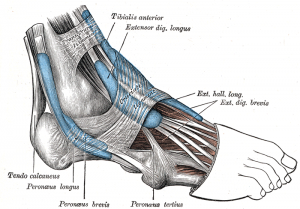Peroneal tendinopathy is an uncommon problem with the tendons on the outside of the ankle joint. The problem almost always happens in athletes where the loads on these structures are so much higher. There are two peroneal muscles on the outside of the leg whose tendons pass round the outside of the ankle joint with one tendon attaching on the outside of the foot at the base of the fifth metatarsal. The other tendon passes under the foot to attach to an area near the middle of the arch of the foot. The muscles have many different functions, but a primary one is to prevent the ankle rolling outwards and ending up with a sprained ankle. As they work hard at that task, the load on the tendons can be too much for the tendon to take and they end up with a peroneal tendonitis.

Typically the problem starts off with pain either above or just below the outside ankle bone with or without some swelling. In some the swelling develops later. With continued activity the pains becomes more persistent and progressively worse. A common finding in those with peroneal tendonitis is a low supination resistance. This means that it is easy for the ankle to supinate or roll outwards. This will cause the peroneal tendons to be very active, so if you then combine it with higher level of sports activity, then the tendon is at high risk for an injury.
The treatment of peroneal tendonitis almost always starts with reducing the load by decreasing activity level and the use of shoe wedging or foot orthotic to pronate or tip the foot inwards so the muscle does not have to work as hard. Ice and anti-inflammatory drugs can also help reduce the pain and swelling. Over the medium to longer term increasing load by the way of exercise needs to be placed on the tendon so that it can adapt to the loads placed on it. In a few cases, surgery is indicated.
{openx:878}